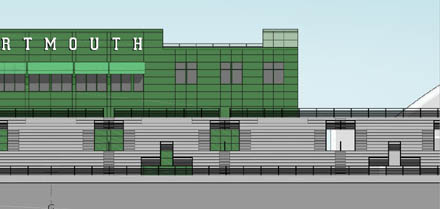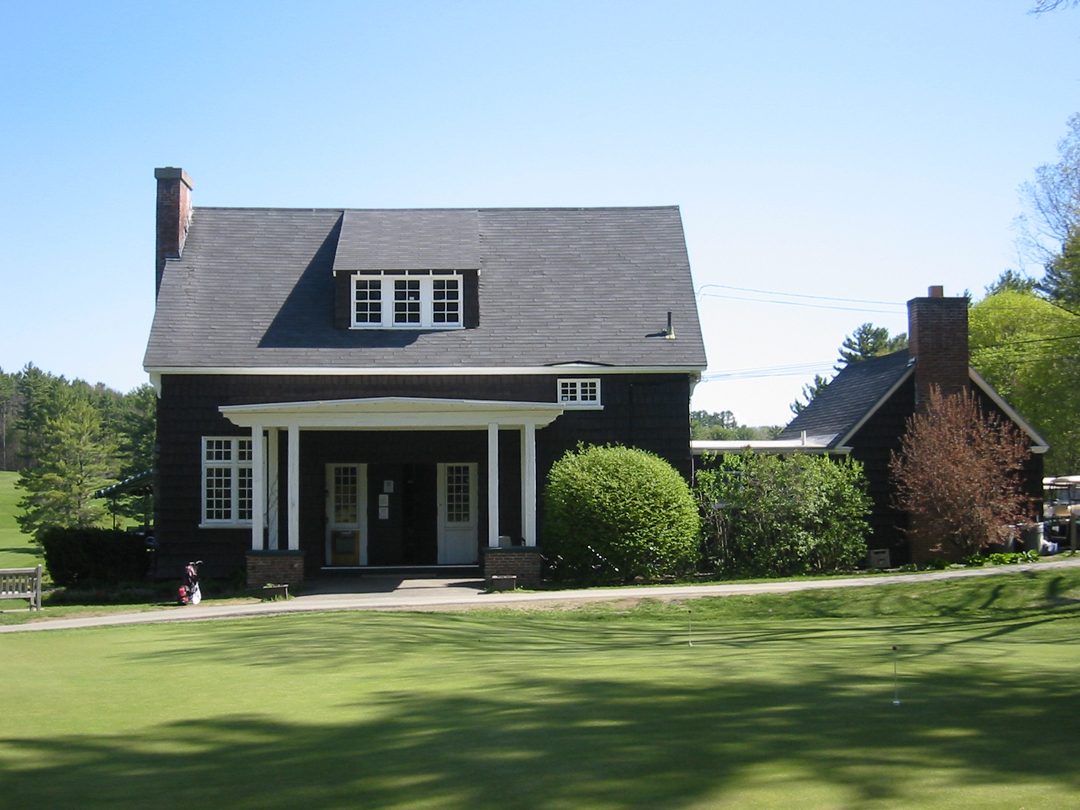The OPDC has exterior photos of Floren, and the Big Green Alert Blog has the first photos of the completed interior. The smart classroom mentioned in the blog and on the project page is presumably for team training sessions, not Dartmouth academic classes.
Category Archives: Memorial Field
Photo updates for construction projects
The OPDC has posted photos of the progress on the new Varsity House (one of the photos shows Memorial Field in the context of the campus), the Montgomery House renovation (check the pondside facade), and the Soccer Field (with the turf in place and grandstand going in).
Most notable are the photos of the landscaping between Berry and Maynard Street, or Berry Row. See the substantial walkway that organizes the whole project, for example.
Floren nearly finished
A large photo of Floren appeared on the cover of the Sports Weekly, and Big Green Alert Blog noted that many of the major spaces within the building have been named.
—–
[Update 11.12.2012: Broken link to cover replaced.]
Floren Varsity House construction photos
Some more shots of the progress on Floren, mostly interiors, are available from the Big Green Athletics.
Rolfe Field next for rebuilding
Dartmouth Life has an update on new athletic facilities and notes the upcoming renovation of Red Rolfe Field. Artificial turf will replace the grass, the dugouts will be rehabilitated, and a new scoreboard will replace the old.
War Memorial Garden created
The Zahm Memorial Garden, which filled the sunken space in front of the Hinman Boxes alongside the Inn, has been redesigned as the War Memorial Garden by Saucier + Flynn. The WWII/Korea memorial, a granite plaque, has occupied the end wall of the Inn since it was moved from under the Hood’s upper bridge in the early 1990s. The school moved the Vietnam Memorial, a sculpture, from the Collis Center to the garden. The Class of 1945 also gave the garden a plaque.
Athletic bubble will not happen
The possibility of building a temporary bubble (an Air-Supported Structure) over one of the Chase Fields for football practice was discussed during the winter (The Dartmouth) and covered conclusively by the very active Big Green Alert Blog (earlier and later stories). Bubbles turn out to be beautiful (as at the Stadium) but quite expensive.
—–
[Update 11.12.2012: Broken links to news article fixed and to Stadium Bubble replaced.]
Football history is big now
A large amount of interest in the history of American football is accompanying the fiftieth anniversary of the Ivy League. The Big Green Alert Blog has linked (more) to trailers for two new films about Ivy football: The League and For Love and Honor, which is based on Mark F. Bernstein’s Football: The Ivy League Origins of an American Obsession.
Both films appear to give some credit to the myth that football began in 1869 when Princeton played Rutgers. (The trailer for the first film mentions that game; the book upon which the second is based also mentions the game.) As has been noted here before, although the teams called their game “foot ball,” the fact that the British still call soccer by that name should be a tipoff: the teams were actually playing soccer, which was and is also known as Association Football. Rutgers acknowledges that the game was FA football and not rugby football in its website about the game.
Although the teams that played in the 1869 soccer match might be called the first American football teams, since they later switched rules to play rugby against other schools, the match itself was not half as significant as the 1874 Harvard-McGill rugby match or the 1875 Harvard-Yale rugby match, either of which is more properly known as the birth of intercollegiate football.
—–
[Update 11.12.2012: Broken link to Love and Honor replaced with link to Eight; broken link to
The Fifth-Down Game
Some of the film that helped decide the Fifth-Down Game in 1940 appears in a short documentary about the game. The Review has an article about the game (“Fifth Down and Goal to Go: Dartmouth Spoils Cornell’s Title Hopes”).
—–
[Update 11.10.2012: Broken link to Review article removed.]
Ivy Football
The New York Times examines the decline in Ivy football attendance that accompanied the shift from NCAA Division IA to Division IAA.
That decline is one of the reasons why Princeton recently demolished Palmer Stadium (Henry J. Hardenburgh, 1914) and replaced it with the lower-capacity Princeton Stadium (Rafael Viñoly, 1998), and why Dartmouth recently replaced some of Memorial Field’s seating with the Floren Varsity House (Centerbrook, 2006).
(The Times notes that Ivy schools’ teams “were perennial national champions from 1869 to 1939.” That should read “from 1874 to 1939,” since 1874 was the first time college football was ever played in the U.S. (Harvard v. McGill). The game that teams played for several years following 1869 was soccer. The confusion might come from Hickok Sports, which lists pre-1874 soccer games at the head of a line of football champions, or from the Rutgers University football page, which still claims that the 1869 game makes Rutgers the home of college football, although the very same webpage acknowledges that the game was played under rules “adopted from those of the London Football Association,” i.e. soccer. The first game of college football ever played between two U.S. teams was the Harvard-Yale game of 1875.)
—–
[Update 11.10.2012: Broken link to Princeton Stadium news item replaced with Wikipedia link.]
The historic Hanover Country Club House
The Hanover Country Club would seem to be Dartmouth’s oldest athletic building, a nineteenth-century barn remodeled as an Arts & Crafts clubhouse by Homer Eaton Keyes in 1916. It is still in excellent shape and well used, although there has been talk for several years of replacing it, presumably with a clubhouse some distance from campus on Lyme Road.
(The school’s oldest intercollegiate athletic facility must be the Alumni Oval of 1893, which was remodeled as Memorial Field and is being remodeled again this summer — meaning that the site and the form have been replicated through the years but that none of the original materials survive.)
[Update 09.12.2006: clubhouse remodeling date corrected.]
Varsity House progress
Bruce Wood reports at Green Alert on town zoning approval for the Varsity House, noting the speed of the project and the fact that it will dismantle and reassemble the upper rows of the existing bleachers rather than demolish the whole structure — which seems very frugal.
The plans indicate that the football locker rooms will be located in the building, alongside the east side of the field. This probably means that both teams now will emerge from the visitors’ stands before each half.
Varsity House under construction
Construction on the new Varsity House started February 22, and detailed information on the latest addition to Dartmouth’s 113-year-old athletic park appeared on line last week.
The building has a project page that includes several November 2005 renderings that now depict the building in red brick, like the Gym, rather than in the green panels implied by the last rendering released.

This early design dated June 10, 2005 will not be built.
The Park Street facade, which will become the right field wall for Red Rolfe Field, is visible for the first time, and the site plan appears to indicate that Rolfe gets a new foul pole.
The third level plan indicates that it will contain mostly offices, with the prime spots overlooking the field held by a meeting room, a conference room, and a sort of lounge — a big room with comfortable chairs, not the row of skyboxes one might have expected.
Contrary to previous speculation here, the existing east stands will not be demolished, only partially disassembled and reinstalled to the south, in front of Leverone.
Oxon. v. Dartmo.
In the wake of Britain’s education fees controversy, The Guardian has seized on the similarities between the endowments and enrollments of Dartmouth and Oxford to compare Dartmouth favorably to the English institution.
Dartmouth’s stadium, tiny in Ivy terms, comes out as peculiarly impressive in the article because it has enough seats for everyone…
Somehow it is hard to picture American football as seen from an English football terrace (see an image of Arsenal’s new stadium in the UAE, proof that terraces are not a result of budget constraints; terrace stories; terrace songs and chants).
The author of the Guardian piece might be shocked to learn that “enrollment” in the U.S. means total students, not just the entering class. That means that the comparison is even less valid: Dartmouth is less than one-quarter the size of Oxford’s 17,000 “enrollment.” There are dormitory clusters at Dartmouth that are larger than Oxford colleges.
[Update 12.12.2006: Enrollment information added.]
